My wife’s grandfather was a hero of mine. He passed away recently with very little fanfare at age 96, but this extraordinary man was one of the first paratroopers in the Army. After breaking his leg on a training jump he was assigned to a conventional Infantry unit after he healed. He served in North Africa, fought with Patton across Sicily, and slogged up the Italian peninsula through places like Rome and Monte Cassino. Also, he enlisted in 1940 as a Private and left the Army in 1945 as a Sergeant Major.
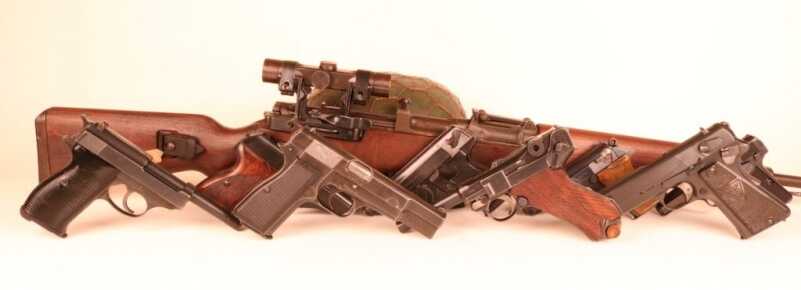
The Germans issued a bewildering array of combat handguns during World War 2. Drawn from sources both domestic and occupied, these guns served in all branches of the German armed forces.
Ever resourceful and a product of the Great Depression, there was very little this man could not do. On the troop ship coming back from the war, he took a stock German P38, stripped it down, and silver-plated it using a silver dollar and a jeep battery. He sold the shiny pistol to an Army doctor on board who had never been anywhere close to combat for $400. That’s more than $5,000 today. The hapless physician assumed that Goering himself must have been the only one to wield a silver-plated P38.
Military Mishmash
Adolph Hitler’s megalomaniacal aspirations stretched his nation and his military to their breaking point and beyond. Actively engaged in a global war on three fronts, the German war machine was forever short on armaments. By the end of the war both children and retirees were mustered out in the final defense of the Reich. In no place was the Germans’ desperate shortage of weapons made more manifest than in combat handguns.
The humble handgun does not win wars. Modern special operators occasionally wield the handgun as a primary weapon, but this was rare in WW2. Pistols during that time were most commonly badges of rank or tools of execution. Carrying one can be a great boon to morale, but this was not the tool that topples governments.
The Germans produced vast quantities of indigenous handguns, but they had to reach out to their occupied territories to meet the ever-growing demand. Early in the war most all of the pistols used by Germany were well built and effective. By the end around-the-clock strategic bombing had taken its toll. Even domestically produced versions became crude and rough. Those guns made by slave labor in the occupied territories were at times unsafe. Here is a brief roundup of the many-splendored handguns used by the Wehrmacht, Waffen SS, Luftwaffe, and Kriegsmarine during World War 2.
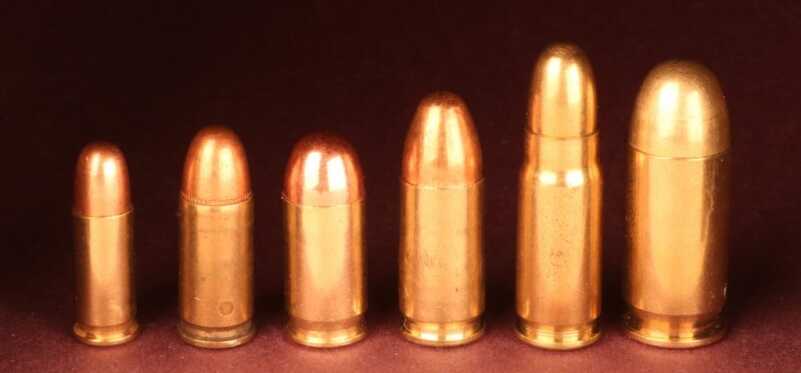
Feeding all these different pistols must have been a gargantuan chore. From left to right are the .25ACP, the .32ACP, the .380ACP, the 9mm Parabellum, the 7.63x25mm, and the .45ACP. Handguns firing each of these disparate rounds found their way into German wartime service
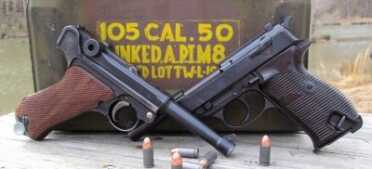
Georg Luger’s P08 Parabellum was one of the most iconic handguns ever built. A leftover from the previous world war, the P08 was a coveted combat souvenir.
Georg Luger’s P08 Parabellum
An evolutionary development of an earlier Borchardt design called the C-93, the eponymous Luger pistol was an elegant and overbuilt combat implement. Of all the common souvenirs from the war, it was the Luger that was most fiercely coveted. The P08 Parabellum fired the standard 9mm cartridge via a brilliant toggle-locked adaptation of the human knee joint.
The Luger fed from a single stack 8-round box magazine and sported a remarkably mushy single action trigger. Although the sights were too small, everybody’s sights were too small. The P08 pointed naturally, but its meticulous manufacture made it overly susceptible to battlefield grunge.

The Walther PP and PPK were simple unlocked blowback guns firing predominantly .32ACP and .380ACP rounds. Thin and concealable, these compact weapons remain popular today thanks to a certain fictional British MI6 agent with an affinity for them.
The Walther PP and PPK
Designed in 1929 as a Law Enforcement weapon, the PP-series pistols introduced the world to the single action/double action trigger on an autoloading handgun. Chambered predominantly for the .32ACP round, this tidy little defensive gun fired via unlocked blowback. The PPK was slightly stubbier than the PP but used the same basic action.
The PP-series pistols served with all branches of the German military primarily as an officer’s weapon. Its small footprint of the gun made it easy to carry, while its advanced design offered solid close quarters combat performance. The .32ACP round was grossly underpowered but remained nonetheless effective for a close range killing shot to the base of the neck.
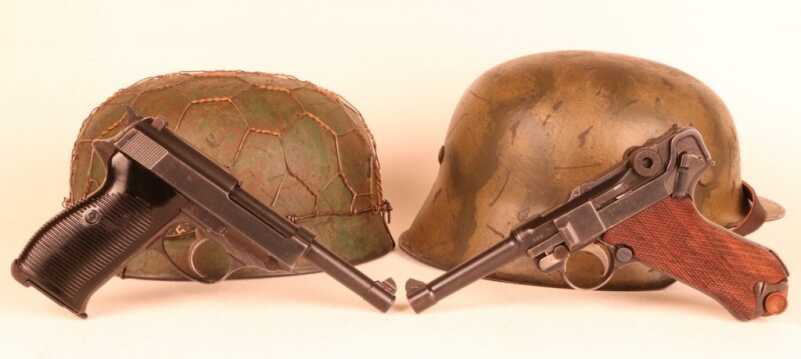
The Walther P38, shown here alongside the P08 Parabellum, was arguably the most advanced combat pistol design of the war. Sporting a single action/double action trigger and reliable action, the P38 was in active military service through the 1980s.
The Walther P38
The P38 reflected an evolutionary development of the trigger system of the Walther PP-series pistols. Offering true single action/double action operation, the P38 was arguably the most advanced combat handgun design of the war. It fed from an 8-round box magazine and employed the European-standard heel-mounted magazine release.
The P38 was made in both Germany and Czechoslovakia, and quality varied based upon how late in the war the gun was produced. Just shy of half a million of these guns saw action, and it remained in active military use up until the 1980’s. Glock pistols replaced the P38 in Austrian Army service in 1983.

The Mauser HSc offered rakish lines and several prescient features. The slide locked to the rear on the last shot fired but dropped automatically when a fresh magazine was inserted.
The Mauser HSc
The HSc competed in the same space as the Walther PPK. Intended for Law Enforcement use as well as service as an officer’s close combat tool, the HSc was phenomenally advanced for its day. Sporting science fiction lines and features not bested even today, the HSc was decades ahead of its time.
The HSc included a semi-shrouded no-snag drum hammer that was accessible by the shooter’s thumb. A slide-mounted safety blocked the firing pin but, unlike that of the PPK, did not drop the hammer. The slide locked back on the last round fired, but there was no manual slide release. An operator simply slammed in a fresh magazine, and the slide closed automatically. Nothing is faster even today. Had it not been for the gun’s heel-mounted magazine release it might have been the most efficient combat pistol design of the war.
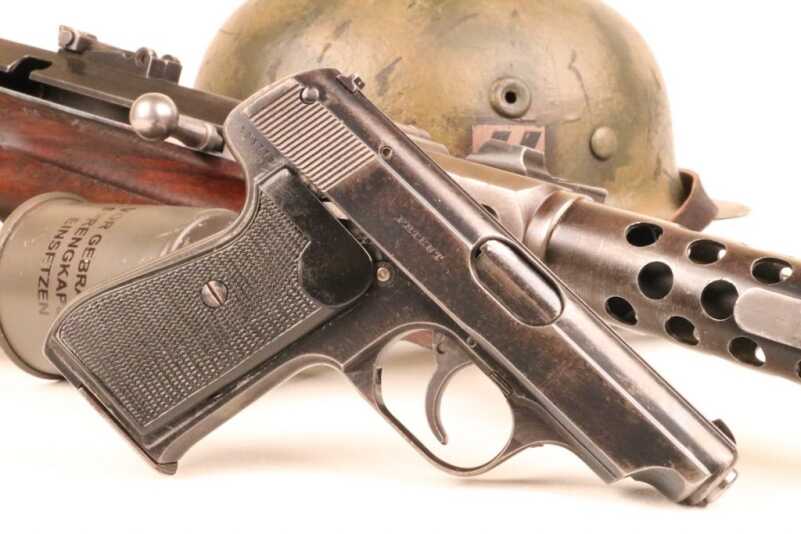
Sauer 38h introduced the world to the thumb-activated hammer-drop safety subsequently incorporated into the SIG SAUER P220-series handguns.
The Sauer 38h
The Sauer 38h was another entrant in the running for use as a German pocket pistol that competed with the HSc and PPK. Firing the .32ACP round by means of an unlocked blowback action, the 38h fed via an 8-round box magazine. Slim and svelte, the 38h incorporated a number of prescient design features.
The most striking aspect of the 38h was the manual frame-mounted decocker. Accessible by the shooter’s right thumb, this pivoting lever allowed the hammer to drop safely on a live round. This same component found its way onto the modern 220-series SIG pistols. Around 200,000 38h pistols saw service, and SS commander Sepp Dietrich carried one during the Ardennes Offensive that came to be known as the Battle of the Bulge. This particular gun sold at auction for more than $40,000 within the last decade.
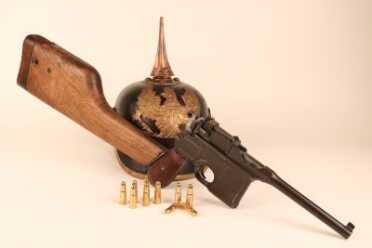
Mauser Broomhandle was an obsolete World War 1-era design, but it still saw fairly widespread service early in the war by the Waffen SS.
The Mauser C96
The Mauser C96 was the world’s first widely successful autoloading pistol design. Titled the Broomhandle based on the striking image it cut when mounted to its detachable holster stock, the C96 fired either 7.63x25mm or 9mm Parabellum via stripper clips fed from the top. A selective fire version fed from detachable box magazines.
The C96 was obsolete by the Second World War, but still saw service with Waffen SS troops, particularly early in the conflict. Expensive to produce and a bit unwieldy in action, the C96 was nevertheless compact and powerful. Mauser Broomhandle was produced both under license and not in large quantities, particularly in Spain and China.
The Browning Hi-Power
The last design of master gun designer John Moses Browning, the P35 Browning Hi-Power was completed after his death by a Belgian named Dieudonne Saive. As most know, Hi-Power incorporated a superb single-action trigger along with a revolutionary tilting-barrel short-recoil locking system. This mechanism was subsequently incorporated into almost every modern combat handgun on the planet. The Saive-designed double column, single feed 13-round magazine offered nearly twice the onboard ammunition load of comparable guns.
The Hi-Power was designated the Pistole 640(b) in German service and was produced in occupied Belgium throughout most of the war. Mainly used by Waffen SS troops and Fallshirmjagers, some 319,000 copies were produced. It was a coveted combat handgun on both sides of the lines.
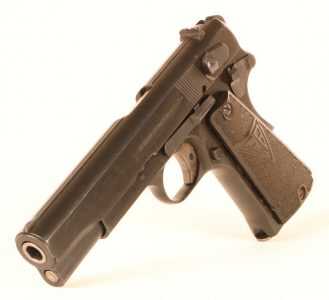
The P35 Browning Hi-Power saw service with German Waffen SS and Fall-schirmjager forces as the Pistole 640(b).
Radom wz. 35 Vis
Colloquially referred to as the Radom after the Polish city in which it was produced, the Poles actually called the gun the Vis which is Latin for “Force.” A short-recoil design on the Browning pattern, the Vis fired 9mm Parabellum from an 8-round box magazine. The Vis was a prized Axis weapon issued primarily to Fallschirmjager troops.
The Vis was produced by Polish slave labor in occupied Poland and suffered from persistent efforts at sabotage as a result. Polish workers would smuggle component parts off of the production lines to assemble weapons at home for use by Polish partisans. Ultimately the Germans shifted barrel production to Steyr in an effort at curbing illicit production of these guns. The industrious Poles still hand-built barrels and kept the weapons in the pipeline to underground fighters opposing German occupation troops.
FN Model 1922
The FN Model 1922 was an elongated service version of the Browning 1910 pocket gun that Gavrilo Princip used to assassinate Archduke Ferdinand and precipitate World War 1. FN’s M1922 could be found in both .32ACP and .380ACP chamberings feeding either 7 or 6 rounds respectively through a single column box magazine. A straight blowback design, the M1922 was issued predominantly to Luftwaffe fliers.
The M1922 was produced alongside the Hi-Power in occupied Belgium and remained available for commercial sale up through 1942. It incorporated a triple safety mechanism consisting of a magazine safety, a grip safety, and a manual safety lever. Widely used throughout the war, the M1922 even served as a private purchase handgun by Japanese military officers.
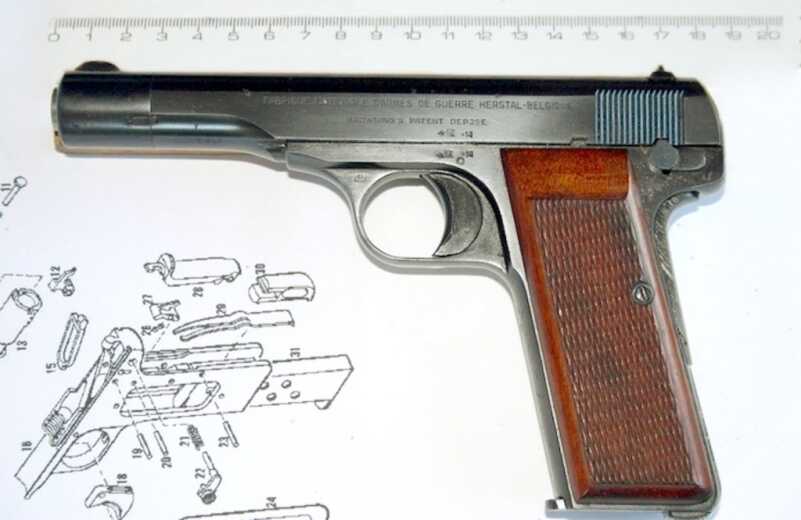
The FN M1922 was produced alongside the Browning Hi-Power in occupied Belgium and served widely with the German Luftwaffe.
Small Fish
The Spanish Astra line of combat pistols was chambered in .32ACP, .380ACP, 9mm Largo, and 9mm Parabellum. Just over 100, 000 of these guns were delivered to the German armed forces by the end of the war. As the Astra guns fired via unlocked blowback they demanded a heavy slide and recoil spring along with robust construction.
One of the strangest service weapons issued by the Nazis was the Kongsberg Colt. Produced in Norway, this .45ACP handgun was a copy of the Colt 1911 service pistol used in all theaters by American forces. Issued to the German Wehrmacht as the Pistole 657, around 8,200 of these weapons were produced though few saw service.
Keeping these different guns fed and maintained must have represented an impossible task. In desperate far-flung battlefields ranging across continents, it was likely not practical to service all the various handguns used by German combatants. While the practicalities of issuing these weapons seemed doomed from the outset, it does make collecting odd old German service pistols a fascinating exercise.

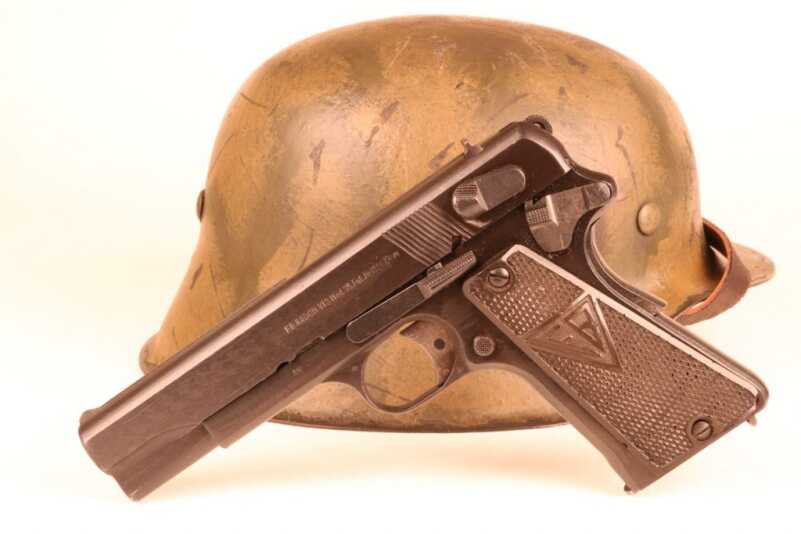

The comment about the .32acp is just ridiculous. That cartridge has more than enough penetration to be very effective, even through things like heavy greatcoats. It’s certainly a much better choice than the very low velocity “.380” revolver round issued by the Brits during WW2. That’s why it was the most commonly issued service pistol caliber of WW1
I have two of these guns listed The Sauer 38h and luger P08. The 38h is really loud but shoots OK. The luger is almost like new 98%. Almost no wear on the bluing.
My neighbor is of German descent. He came to the US in the early 50s, when about 12 years old, with his mother. His dad was a German soldier who was killed on a train, bombed by the allies while en route to Russia. His dad’s brother became a police officer after the war, in some small town in Bavaria. Sometime around 1980 he gave my neighbor his service gun, a beautiful Walter PPK. He left the gun with relatives in Germany for many years, then decided to transport it to the US (in a car he bought over there).
I bought the gun from my neighbor this year. He’s getting old and offered it to me. We wrote up the history of the gun in the form of an affidavit. He included 2 original holsters- one original and one dress German police, the original magazine and police issue spare, 10 boxes of the German .32 ammo, the original box, cleaning kit etc.
The gun is WW2 1940 production and he swears up and down it was made in Germany. Many were made in France during the war, after the Nazi occupation began. This PPK is mint and really nice. My gunsmith collector buddy tells me to handle it with care and with gloves on. I have not shot it yet, but will not be able to resist putting one of the 25 count boxes of .32 ammo through it.
I was an army brat who spent much time at the Patton Museum prior to 1968. The pistol collection there was miserable in quality and diversity. I donated my dad’s pistols (Maj. Granville O. Black) and put in a few of mine. It has since been remodeled. I hope they paid more attention to small arms than one glass display.
My Dad too brought home a PPK and P38. I remember handling them one time before my Mom made him sell them as they needed the money. Maybe that is why I enjoy firearms to this day, much to the displeasure of my Mom. I would say I was about 5 years old or so. He, like others rarely talked about the war..He had PTS back then, with nothing for help. I , like others too wish he was still here. So brave back then, so we could have what we have now.Thanks Dad!!
I have an Ortigs in 32 Auto made in Germany…but cannot find a year of manufacture or if they used that during the Spanish War Any ideas?
Very interesting article, thank you for putting in the time and effort to create it and for sharing it with us.
My father brought back a Beretta Bre Vet, .380 . He gave it to me and it is still in perfect condition. It will go to my son someday
I was one of the first baby boomers. My father was in WWII and was one of the first soldiers returned to the States. I don’t remember much of him because he died early, but I remembered that he had a P-38. I asked him about the Luger. He had one, but it had a lead-filled barrel.
They both disappeared from the house as soon as I began to show interest. My mother hated guns. But we lived in an apartment, where we commonly left the home through the back door of a three-story apartment building. Our next door neighbor kept an M-1 rifle just outside the door, and I could see it every day, but, of course, was not allowed to touch it.
But it was that P-38 that interested me the most. I wish mom had not made him get rid of it. He claimed it was one of the best pistols around. He was probably right, though my first handgun I loved to shoot was the Model 1911.
“Titled the Broomhandle based on the striking image it cut when mounted to its detachable holster stock, ” that is funny i always thought that this particular moniker had to do with a because of its round wooden handle grip and nothing to do with the stock/ holster that could also be a leather one
Hey Will,
What do you think the “hapless physician” was doing over there? Whom do you think casted (or maybe even surgically repaired) your wife’s grandfather’s leg after he fractured it on that training jump? Your foolish, krappy little criticism of the doctors who also served in WWII (and continue to serve here and abroad), makes you sound like the other clown that has nothing but contempt for the medical profession – your obvious hero Obama. Your quasi-media skillset would best be served on mother-jones or some other progressive platform, not here.
Hey Dr. Davis here’s the definition:
hap·less
ˈhapləs/
adjective
adjective: hapless
(especially of a person) unfortunate.
“if you’re one of the many hapless car buyers who’ve been shafted”
synonyms: unfortunate, unlucky, luckless, out of luck, ill-starred, ill-fated, jinxed, cursed, doomed.
BTW Will Dabb is a M.D. as well… instead of throwing inappropriate personal insults do some research so you get a clue! You’re the one who is sounding like the ill tempered liberal here.
Hey, Davis MD,
Lighten up on Will Dabbs MD. I’ve followed Dr Dabbs for several years and always enjoyed his self-deprecating humor and firearms expertise. He has spent his share of time in the military and medicine and is an ardent advocate of both. I find his style quite refreshing and enjoyable; he is able to poke fun at himself, our politically correct society and life in general—a nice change from the usual pompous, arrogant drivel most physicians produce. He is a frequent contributor to GUNS and American HANDGUNNER magazines; I think you would find his articles very informative.
Oh yea, I was an infantry officer in the 82d Abn for 4 years and an US Army MD for 8 years. I appreciate your zeal in defending military physicians and medicine but you’re way off base in targeting Dr Dabbs.
Thanks for the Merriam-Webster cut & paste…real helpful. I respect your defending Dr Dabbs, but I’m not apologizing. No way Dr Dabbs was being genuine & respectful with his “…sold the shiny pistol to an Army doctor on board who had never been anywhere close to combat” comment. Think about it BigJohn, the doc was on the same troop ship coming home from war-torn Europe!
The Army doctor that Dr Dabbs verbally portrays as a cowardly fool was neither – if he was over in Europe during WWII that doc helped a lot of our guys & was a lot closer to combat that Dr Dobbs has ever been. The comment didn’t need to be said. To me, it shows what kind of a person Dabbs is and it reminds me of the stupidity and disrespect of the left.
Another one to add to the list. I have a French Unique ‘Kreigs Model 7.65 pistol made in Hendaye France from 1940-45 during the Nazi occupation. My uncle brought back after the war and it has all the Nazi Waffenampt markings on it. It has virtually no bluing on it, but it still shoots great and is a handy little family heirloom.
Re: the Walther PPK–“The .32ACP round was grossly underpowered but remained nonetheless effective for a close range killing shot to the base of the neck.”
Let nobody forget that a lot of those “necks” belonged to Jews and other hapless Nazi victims. Your writer might have been well advised to jubilate over some other aspect of the weapon.
Please point out the jubilation in the authors description of how the pistol was used. It seems to me that you’re hypersensitive and looking for something to rub against.
The dirtbag who killed the most used .25acp/6.35mm Google vassily blokhin,he was stalin’s favorite executioner
Re: the Walther PPK–“The .32ACP round was grossly underpowered but remained nonetheless effective for a close range killing shot to the base of the neck.”
Lest we forget, a lot of these “necks” belonged to Jews and other hapless victims of the Nazis. Writer might have been better off jubilating over some other aspect of the weapon.
“Jubilating”? Seriously? He was stating historical facts and describing what the underpowered round was used for. He didn’t seem to be “Jubilating” over anything. Let’s not try to assume we know the mind of the writer and try to make him out as a Nazi sympathizer. History, no matter how distasteful, is still history. This is the same mindset that is leading to the destruction of Civil War-era statues being destroyed. It doesn’t change what has already happened, it just removes some of the reminders, which is a bad idea. “Those who do not learn from history are doomed to repeat it.” or something akin to that.
Amen
You left out the Mauser model 1910/34 which was produced in both 6.35 and 7.65 mm. Both were fine pistols though somewhat underpowered.
Supposedly, and correct me if I’m wrong, the German government bartered with the Spanish government for the manufacture of the Star 9mm to supplement German government employees as everyone from the postal worker to the meter maid was required to be armed and there just wasn’t enough German handguns to go around.
This true. I have a Star model B in 9mm with the german armorers marks on it. A few years ago, some more of the german marked Star pistols were imported into the U.S. and the brought an additional $100 to $150 extra over an unmarked model Star pistol.
Doesn’t look like a Hi-Power to me. Looks like another picture of a Random.
My great Uncle brought back a Browning Hi-power he picked from a Belgium factory.
It was complete and functional but hadn’t been blued. Eagle and swastika on the slide.
The author says the hapless physician had not been close to combat. This author is an egotistical jackass.
Hey Mitch, that was a “tongue in cheek” comment made by the author; who himself is a physician. What is it about the internet where judgemental assholes feel so free to openly criticize others on personal level? I guess one can be brave at their basement keyboard where there is no real fear of catching a deserving fist in the face.
That said, Dr. Dabbs thank you for another insightful article. I really enjoy the way you blend technical data, history with personal experiences in your articles. You are rapidly becoming one of my favorite gun writers, keep up the good work.
My great uncle was one of the first paratroopers too jumping on D-Day. He was one of the coolest guys I ever knew but he never talked about the war. Some photographer took a pic of him standing in the door getting ready to jump and that pic was plastered in a lot of magazines even Time Life or whatever it was called back then.
Anyway – My stepdad had a 32acp PPK that was a sweet dream to shoot but it had a hair trigger that was dangerous as hell !
It got stolen by a moving company when he moved in the 80s.
Gotta raise a cold one to those old war horses of years past , they went through hell to let us sit here and pound on a keyboard … and those that followed in their footsteps.
I had 4 uncles in WWII. They were tough as sledge hammers. What I would give to talk to them now. I never had much interest when I was younger but things have change since I’ve gotten older.
This article skips the well known fact that during the end of the war with scarce materials available many of these arm were produced with receivers of aluminum in place of steel. Odd metal materials adds to the rebuilders dilemmas.
Still missed one. I have an old Femaru someone brought back from the war. The German ones had an actual safety and came in 32 vs 380. Has the nazi marks, but in really rough shape and near impossible to buy parts for.
P.S. I suppose many people haven’t seen or heard of a S.A.C.M. It’s basically a bright blued smaller version of our 1911. The only time I ever saw a German Soldier on a news reel using a gun that wasn’t a Luger, or a P-38, or a Walther PP or any other German handgun was this man using it to execute (coup-de- gras ) of a machine gunned partisan. In my collection I don’t have any WWII Sigs, but I know they pretty much resemble the PP’s at least the ones I’ve seen in books or TV. I had too make the rounds from .32 shells and bullets I got with the gun, but the guy I got the gun from didn’t turn down the shells enough so they were to long and the gun wouldn’t run right!! The gun is numbered 46–A with the Nazi Eagle over Wa A 257 ( Wa A251?? ) and is 95-98% blued and original with original soft shell holster. My Ian V. Hogg German Handguns book has no reference to this French made during German occupation, but the Nazi markings tell a different story, and that officer shooting that partisan was using a gun that looks like a smaller version of our 1911 I can only think it is a SACM 1935A. My Luger 1918, 2 P-38’s, Walther PP can’t be confused with the SACM and sure as hell can’t be confused with my C-96 made in WWI and has no Nazi markings!! Joe L.
You’ve forgotten the S.A.C.M. M-35 French design of 1935 still being built by the Germans after the capture of the factory in France. It fires an oddball .32 cal.round and my weapon has all Nazi markings with the original holster!! One of my collection of German weapons, the only one which I own is my C-96 that doesn’t have Nazi markings, obviously from WWI or there abouts!! Joe